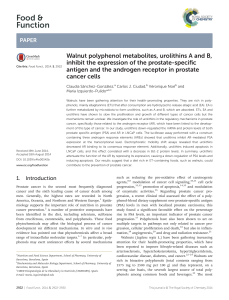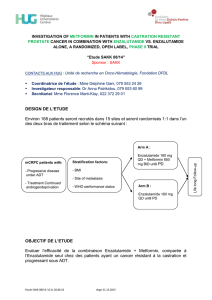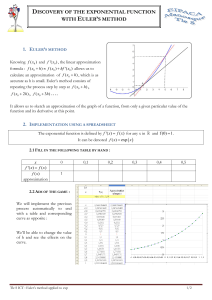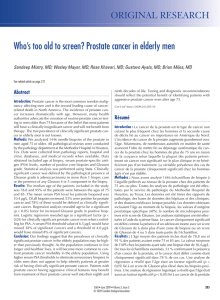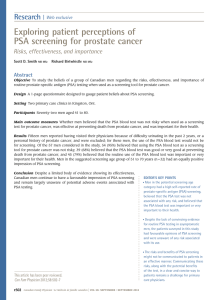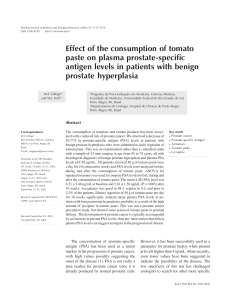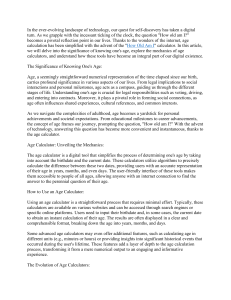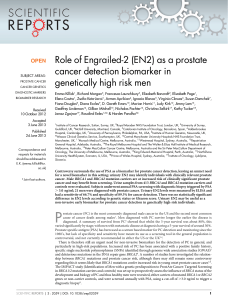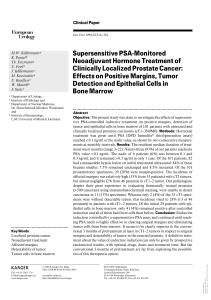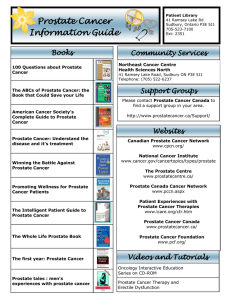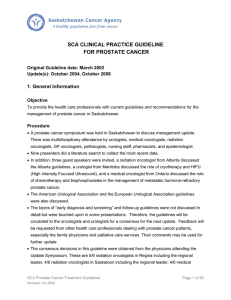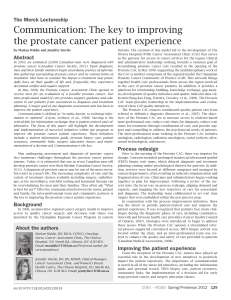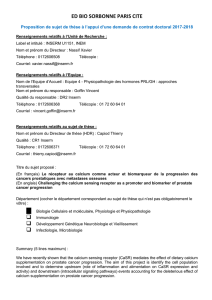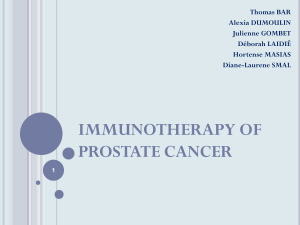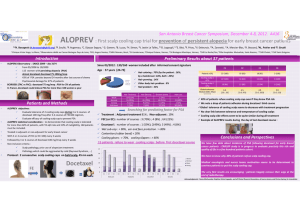Towards institution- and investigator- specific self-updating risk calculators for prostate cancer
publicité
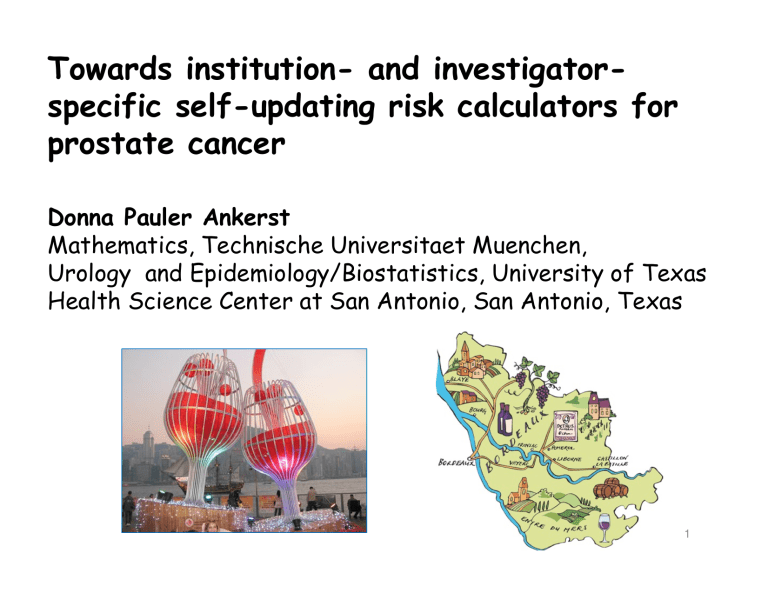
Towards institution- and investigatorspecific self-updating risk calculators for prostate cancer Donna Pauler Ankerst Mathematics, Technische Universitaet Muenchen, Urology and Epidemiology/Biostatistics, University of Texas Health Science Center at San Antonio, San Antonio, Texas 1 The Prostate Cancer Prevention Trial (PCPT) Risk Calculator Thompson, Ankerst et al, NEJM 2004; JNCI 2006 www.prostate-cancer-risk-calculator.com PCPTRC 1.0 PCPTRC 2.0 Based on the provided risk factors a prostate biopsy performed would have a: 1% chance of highgrade prostate cancer, 8% chance of lowgrade cancer, 91% chance that the biopsy is negative for cancer. Please consult your physician concerning these results. Click here to watch a video overview of these results. About 2 to 4% of men undergoing biopsy will have an infection that may require hospitalization. Nominal logistic regression/standard risk factors PSA: enter prostate-specific antigen in ng/mL DRE: enter 1 if digital rectal examination is abnormal, 0 otherwise FAMHIST: enter 1 if there is a first-degree family history of prostate cancer, 0 otherwise PRIORBIOP: enter 1 if there has been one or more prior biopsies performed (all negative for prostate cancer), 0 otherwise AA: enter 1 for African American, 0 otherwise AGE: enter age in years S1 = -3.002 + 0.256L2PSA + 0.016Age + 0.122AA - 0.455PriorBiop 0.039DRE + 0.272FamHist S2 = -7.053 + 0.705L2PSA + 0.048Age + 1.042AA - 0.214PriorBiop + 0.401DRE + 0.225FamHist Risk of no cancer = 1/[1 + exp(S1) + exp(S2)] Risk of low-grade cancer = exp(S1)/[1 + exp(S1) + exp(S2)] Risk of high-grade cancer = exp(S2)/[1 + exp(S1) + exp(S2)] 4 US National Cancer Institute collection of Cancer Risk Calculators http://epi.grants.cancer.gov/ cancer_risk_prediction/ Cleveland Clinic http://www.lerne r.ccf.org/qhs/risk _calculator/ Mike Kattan Cleveland Clinic Completion of randomized trials and studies have brought about a change in the clinical landscape since 2006 Different case-mixes of hospital settings + changes in clinical practice imply constant updates to calculators are necessary (like iphones). Ongoing discovery, validation and FDA-approval of new biomarkers for clinical practice imply a need to incorporate them into existing calculators rather than collect a new cohort from scratch (like adding a room to a house rather than building a whole new house). 7 Completion of randomized trials and studies have brought about a change in the clinical landscape since 2006 Different case-mixes of hospital settings + changes in clinical practice imply constant updates to calculators are necessary (like iphones). Ongoing discovery, validation and FDA-approval of new biomarkers for clinical practice imply a need to incorporate them into existing calculators rather than collect a new cohort from scratch (like adding a room to a house rather than building a whole new house). 8 Prostate Biopsy Collaborative Group (PBCG): in response to urological research community gone out of control Andrew Vickers Memorial SloanSloanKettering Cancer Center 7 European, 3 US biopsy cohorts 25,772 biopsies from 23,070 patients 8,503 prostate cancers AIM: Validation is a property of BOTH the prediction tool and the cohort to which it is applied. 10/7/2013 Vickers et al., Clinical Cancer Research, 2010 9 10/7/2013 10 Externally validate the PCPTRC 2.0 by 3 criteria Steyerberg E. Clinical Prediction Models, Springer, 2009 1.) Calibration: How close are predicted risks to observed risks? 2.) Discrimination: How well does a risk prediction discriminate between those with and without the disease? 3.) Clinical net benefit: Decision-curve analysis that compares the net benefit of using a risk prediction tool to refer patients to biopsy versus referring all or no patients to biopsy (not shown). There are many more, some such as the Brier score, combine multiple metrics; these 3 are most seen in Urology. 11 Calibration of PCPTRC 2.0 Fits the European screening cohorts that similarly use the 6-core biopsy technique on the left. Under-fitting for the clinical cohorts on the right—that is to be expected since these men are referred with symptoms and these use a 12-core biopsy. Discrimination of PCPTRC 2.0 Area underneath the receiveroperating-characteristic curve (AUC) gives the probability that for a randomly selected cancer case and control, the cancer case would have a higher PCPTRC risk. It varies from 50% (no better than random guessing) to 100% (perfect). AUC varies from 52% to 68%, a bigger range than any new biomarker has ever pushed an AUC. We should be worrying more about fixing the cohort effect problem than improving models or how to measure improvement of10/7/2013 models… Cohort ERSPC Goet. R1 ERSPC Goet. R2-6 ERSPC Rott. R1 ERSPC Rott. R2-3 ERSPC Tarn SABOR, US Cleveland Clinic, US ProtecT , UK Tyrol, Austria Durham VA, US AUC for no cancer versus low-grade cancer (%) AUC for no cancer versus high-grade cancer (%) 55.6 88.1 77.0 62.9 46.0 74.3 70.8 51.6 51.8 82.4 76.2 63.8 50.4 74.5 72.3 57.0 56.8 74.5 65.9 66.3 67.6 71.3 60.8 67.9 56.8 62.1 61.7 59.6 57.1 75.9 70.1 64.0 60.5 73.0 65.3 64.6 61.4 71.6 66.5 66.1 AUC for lowgrade versus high-grade cancer (%) Generalized c-index (%) (prevalence weighted AUCs) 13 Can one risk calculator fit all? We don‘t think so. Empirical risk curves according to PSA across 11 cohorts in the PBCG Vickers et al., Clinical Cancer Research, 2010 After adjusting for known risk factors, age, DRE, race, family history, a cohort effect is still significant. There remains a case-mix effect across different types of hospitals that cannot be explained away by covariates, yet are not 14 the fault of the model (Vergouwe et al, Am J Epidem, 2010). Another question: what happens when your cohort becomes outdated? The PCPT cohort was collected from the late 1990’s through 2004. The PCPT protocol for the biopsy procedure was a 6-core sample, but modern practice collects 12- or even more cores. It has been documented that a higher number of cores increases the likelihood of detecting cancer and high-grade cancer. 15 Prostate Biopsy Collaborative Group PBCG 2.0 Cheaper to build a new house if the foundation is too old? Hamburg Canadian Consortium Mayo Clinic Milan Cleveland Clinic UCSF Durham VA UTHSCSA Puerto Rico Data elements: Same as before but now ask if ever had a prior PSA test and if it was elevated. 16 Steyerberg recalibration versus Bayesian methods To yearly update a risk model: Build a new model from scratch Recalibration in the large: Use log PCPTRC 2.0 risk as offset and estimate new intercept in nominal logistic regression (NLR) Recalibration: NLR to estimate new intercepts and slopes for log PCPTRC 2.0 risk as single covariate Revision: Same as recalibration but allow individual risk factors to enter separately as covariates Bayesian: Use prior to posterior updating on parameters Bayesian likelihood ratio: Use PCPTRC 2.0 as prior odds and update through likelihood ratio on all covariates Automate it from electronic medical records 17 Completion of randomized trials and studies have brought about a change in the clinical landscape since 2006 Different case-mixes of hospital settings + changes in clinical practice imply constant updates to calculators are necessary (like iphones). Ongoing discovery, validation and FDA-approval of new biomarkers for clinical practice imply a need to incorporate them into existing calculators rather than collect a new cohort from scratch (like adding a room to a house rather than building a whole new house). 18 Updating an existing risk tool • Cancer biomarker research is dynamic. • New markers are discovered/tested/validated. • Cannot measure these markers retrospectively on the original participants of a cohort. • For rare genetic markers, large multi-institutional consortiums are required. Problem to be solved How to update a risk calculator built on one cohort with a new risk factor measured on a different cohort? Solution Bayes theorem 10/7/2013 19 From prior to posterior risk X = PCPT Risk factors: PSA, DRE, family history, prior biopsy, race, age Y = New markers Posterior Odds Cancer(Y,X) = Likelihood Ratio(Y|X) × Prior Odds Cancer (X) within a given strata of X, how much more likely is the new marker to be observed in cases rather than controls; estimated from a separate study to PCPT P(Cancer | X, Y) P(No Cancer | X, Y) 10/7/2013 = from PCPT risk calculator P(Y | X, Cancer) P(Cancer | X) × P(Y | X, No Cancer) P(No Cancer | X) 20 Single continuous marker Ankerst et al J Urol 2009 X = PCPT Risk factors: PSA, DRE, family history, prior biopsy Y = log(PCA3) P(Cancer | X, Y) P(No Cancer | X, Y) = P(Y | X, Cancer) P(Cancer | X) × P(Y | X, No Cancer) P(No Cancer | X) 1 2 exp− 2 ( Y − µcancer ) 2 σ cancer 2σ cancer 1 1 2 ( exp− 2 Y − µ no cancer ) 2σ no cancer σ no2 cancer 1 Linear regressions of Y on X in cancer cases and controls separately. µcancer = 1.1926 - .0836log(psa) + .0376age + .1055dre + .0658priorbiop µ no cancer - .6915 - .1137log(psa) + .0577age - .3345dre + .1260priorbiop PCPTRC 1.0 logistic regression exp( β ′X ) β ′X = -1.7968 + 0.8488 log(psa) + 0.2693famhist + 0.9054dre – 0.4483priorbiop σ cancer = 1.0366 σ no cancer = 1.0191 10/7/2013 Confidence,prediction intervals for posterior risk by delta rule. 21 The first validation online shortly after added to website; The impact of publishing algorithms. 22 Incorporating multiple markers Ankerst et al Biom J 2012 X = PCPT Risk factors: PSA, DRE, family history, prior biopsy Y = (log %freePSA, log [-2]proPSA)′ P(Cancer | X, Y) P(No Cancer | X, Y) = P(Y | X, Cancer) P(Cancer | X) × P(Y | X, No Cancer) P(No Cancer | X) PCPT SABOR 1 ′ −1 (Y − µcancer ) exp− (Y − µcancer ) Σ cancer 2 −1/ 2 1 ′ −1 exp− (Y − µ no cancer ) Σ no Σ no cancer cancer (Y − µ no cancer ) 2 Σ cancer µ cancer Σ cancer −1/ 2 2.667 − 0.365 log PSA + 0.0110 Age = 1.385 + 0.627 log PSA + 0.006 Age 0.179 0.121 = 0.121 0.231 3.276 − 0.235 log PSA + 0.002 Age µ no cancer = 2.438 + 0.571log PSA − 0.008 Age 0.128 0.097 Σ no cancer = . 0 . 097 0 . 188 exp( β ′X ) β ′X = -1.7968 + 0.8488 log(psa) + 0.2693famhist + 0.9054dre – 0.4483priorbiop • For more flexibility use multivariate t, skew t, mixtures of skew t distributions • Extend to more than 2 23 outcome groups. Integrated Discriminative Index: Proposed in Pencina et al. (2008) for comparing risk prediction tools 1 IDI = ncancer ncancer ∑p i =1 new,i − 1 ncontrol 1 pnew,i − ∑ i =1 ncancer ncontrol Discrimination slope for risks from the updated calculator (pnew) ncancer ∑p old ,i − i =1 1 ncontrol pold ,i ∑ i =1 ncontrol Discrimination slope for risks from the old (PCPT) calculator (pold) Evaluated on an external Early Detection Research Network cohort of 575 men yielded an improvement: IDI = 6.3% (95% confidence interval 3.0% to 9.6%). 24 Genomewide Association Study SNPS for prostate cancer Some papers report genotype counts/some allele frequencies; latter can be transformed to genotypes assuming HardyWeinberg-Equilibrium. Risk alleles (RA): higher odds for cancer than nonrisk alleles. Minor alleles (MA): lowest frequency. 25 Example: SNP rs100860908, Al Olama et al. 2009 freq (freq/n) TT TC CC Cases (n = 3646) 1913 (0.52) 1457 (0.40) 276 (0.08) Controls (n=3939) 1933 (0.49) 1636 (0.40) 370 (0.09) LR (freq case/freq control) .52/.49 = 1.06 .40/.40 = 1.0 .08/.09 = 0.88 For a new individual with TT on this SNP, his PCPTRC prior odds gets inflated by 1.06 for computing his posterior odds/risk of cancer. 26 Single nucleotide polymorphisms X = PCPT Risk factors: PSA, DRE, family history, prior biopsy; we believe that mutations are inherited or occur before X and so do not need to condition on X. Y = SNP with published genotype or allele frequencies (example T,C). P(Cancer | X, Y) P(No Cancer | X, Y) = P(Y | X, Cancer) P(Cancer | X) × P(Y | X, No Cancer) P(No Cancer | X) Published GWAS study (π (π ) ) (π (π I (Y =TT ) TT cancer I (Y =TT ) TT no cancer I ( Z =2 ) ) ) πˆ πˆ ≈ 1 πˆ πˆ no cancer Z = no.of risk alleles (T ). 2 cancer 2 no cancer (π ) (π ) TC ,CT I (Y =TC ,CT ) cancer I (Y =TC ,CT ) TC ,CT no cancer 1 cancer I ( Z =1) I (Y =CC ) CC cancer I (Y =CC ) CC no cancer πˆ πˆ 0 cancer 0 no cancer PCPT exp( β ′X ) β ′X = -1.7968 + 0.8488 log(psa) + 0.2693famhist + 0.9054dre I ( Z =0 ) , – 0.4483priorbiop 27 Multiple SNPs in LD Y = Y1,Y2 ,...,Yr : Multiple SNPs from different studies that are known from the Hapmap not to be in linkage disequilibrium (LD) ⇒ r P(Cancer | X,Y ) P(No Cancer | X,Y ) ∏ P(Y | Cancer) i = i =1 × r ∏ P(Y | No Cancer) P(Cancer | X ) P(No Cancer | X ) i i =1 r = ∏ LRi × i =1 P(Cancer | X ) P(No Cancer | X ) • Multiple SNPs in LD multiply LR’s • Multiple SNPs not in LD import LD/correlation from the HapMap. 28 Meta-analysis of SNPs from multiple GWAS studies Multivariate metaanalysis of LR’s using van Houwelingen et al, Stat Med, 2002 29 Comparison of SNPs with self-report family history Marker No. controls No. cases (%) Likelihood (%) rs16901979 (No. allele A) ratio 37848 2936 0 34799 (91.9) 2572 (87.6) 0.96 1 2985 (7.9) 351 (12.0) 1.53 2 64 (0.2) 13 (0.4) 2.54 No. FDR prostate 303990 cancer < 60 years 23630 0 302839 (99.6) 23407 (99.1) 0.99 1 1141 (0.4) 221 (0.9) 2.49 ≥2 10 (0.01) 2 (0.01) 2.57 FDR: first-degree relative; from Swedish FamilyCancer Database SNP LR from meta-analysis of 3 GWAS studies 30 The likelihood method allows addition of new SNPs or replacement of new LRs as more GWAS studies finish. However projections show future SNP effects will be smaller and never compete with existing risk factors. 31 Closing remarks Mitch Gail NCI We are not the first to compartmentalize models for easy updating from multiple sources. Gail et al, JNCI 1989 did this for the first online risk tool and has implemented a frequentist approach to incorporate SNPs. His frequentist approach has been replicated for colorectal and lung cancer. 32 Acknowledgements TUM: Josef Hoefler, Sonja Grill UTHSCSA: Russell MacShane, Robin Leach, Ian M. Thompson Bordeaux 33



![READ MORE: Virtual Navigator - Urology - White Paper [285 Kb]](http://s1.studylibfr.com/store/data/007797835_1-2f6426403461f07430ec79c5ed4174d7-300x300.png)


